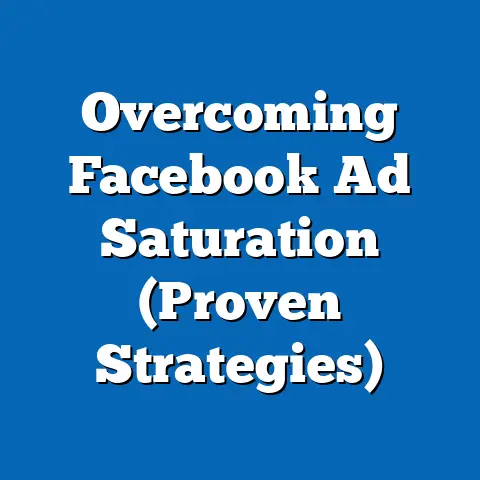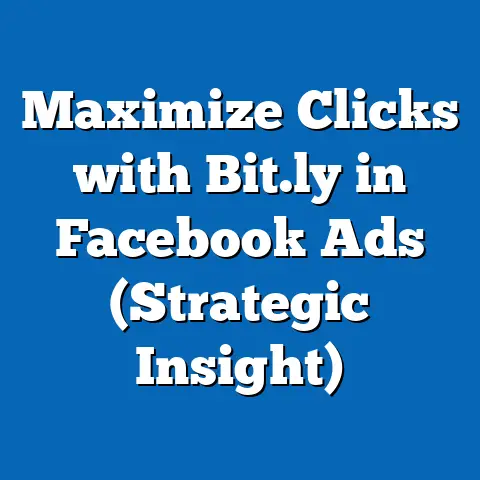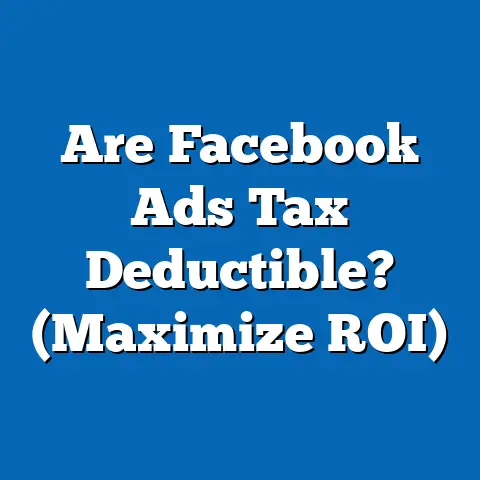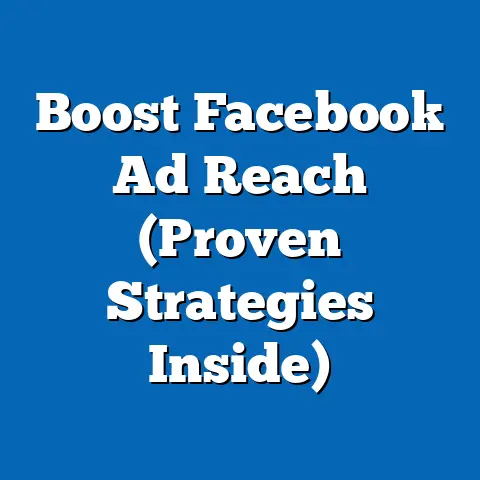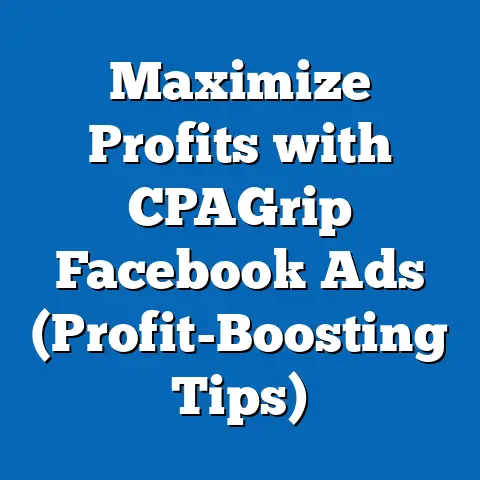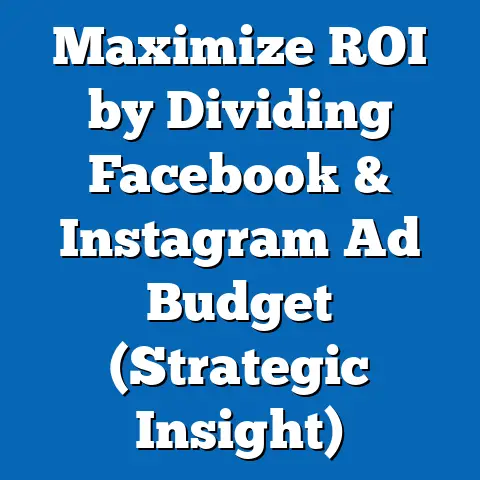Master Facebook Ads for Consultants (Proven Success Strategies)
As a consultant, I know firsthand how demanding your schedule can be. Juggling client projects, networking, administrative tasks, and trying to maintain some semblance of a personal life often feels like a high-wire act. Marketing, unfortunately, often gets pushed to the back burner. But here’s the thing: your success as a consultant hinges on your ability to attract new clients and keep your existing ones happy.
Traditional marketing methods can be time-consuming and expensive. That’s where Facebook ads come in. They offer a powerful and efficient way to reach your target audience, generate leads, and ultimately grow your business without sacrificing your precious time.
Section 1: Understanding Facebook Ads
Facebook advertising isn’t just about throwing money at the platform and hoping for the best. It’s a sophisticated system that, when understood and utilized correctly, can deliver impressive results. So, let’s start with the basics.
What are Facebook Ads and How Do They Work?
Facebook ads are paid messages that businesses can display to Facebook users. These ads appear in various places, including the news feed, right column, Instagram, and Messenger. Unlike organic posts, ads are targeted to specific audiences based on demographics, interests, behaviors, and more.
The beauty of Facebook ads lies in their precision. You’re not just broadcasting your message to anyone and everyone; you’re strategically delivering it to the people most likely to be interested in your services. This targeted approach significantly increases the likelihood of engagement, lead generation, and ultimately, conversions.
Different Types of Facebook Ads
Facebook offers a variety of ad formats to suit different objectives and creative styles. Here are some of the most common:
- Image Ads: These are simple ads featuring a single image and text. They’re great for showcasing your brand or highlighting a specific offer.
- Video Ads: Video ads are more engaging than image ads and can be used to tell a story, demonstrate your expertise, or provide testimonials.
- Carousel Ads: Carousel ads allow you to display multiple images or videos in a single ad unit. This is a great way to showcase a range of services or products.
- Collection Ads: These ads are designed for mobile shoppers and feature a main image or video, followed by a grid of related products.
- Lead Ads: Lead ads are designed to collect leads directly from Facebook. They pre-populate contact information, making it easy for users to submit their details.
The Power of Audience Targeting
One of the most significant advantages of Facebook advertising is its robust targeting capabilities. You can target your ideal clients based on a wide range of criteria, including:
- Demographics: Age, gender, location, education, job title, etc.
- Interests: Hobbies, passions, topics they follow, etc.
- Behaviors: Purchase history, online activity, device usage, etc.
- Custom Audiences: Upload your existing customer list or website visitors to create a custom audience.
- Lookalike Audiences: Expand your reach by targeting users who are similar to your existing customers.
For instance, as a marketing consultant specializing in the healthcare industry, I can target practice managers, doctors, and hospital administrators specifically in the healthcare industry within a 50-mile radius of my location, who are interested in digital marketing, patient acquisition, and medical practice growth.
Setting Clear Advertising Goals
Before you even start creating your ads, it’s crucial to define your advertising goals. What do you want to achieve with your Facebook ads? Are you looking to:
- Increase Brand Awareness: Get your name and services in front of a wider audience.
- Generate Leads: Collect contact information from potential clients.
- Drive Website Traffic: Send users to your website to learn more about your services.
- Increase Conversions: Encourage users to book a consultation, download a resource, or purchase a service.
Your goals will dictate the type of ads you create, the targeting options you choose, and the metrics you track.
Takeaway: Understanding the fundamentals of Facebook ads, including ad types, targeting options, and goal setting, is the foundation for a successful advertising strategy. Define your objectives, know your audience, and choose the right ad format to maximize your impact.
Section 2: Crafting Compelling Ad Content
Now that you understand the basics of Facebook advertising, let’s dive into the art of crafting compelling ad content. Your ad copy and visuals are the first things potential clients will see, so it’s crucial to make a strong impression.
The Importance of a Strong Value Proposition
Your value proposition is the core message of your ad. It should clearly communicate the benefits of your services and why potential clients should choose you over the competition.
What makes you unique? What problems do you solve? How can you help your clients achieve their goals? Your value proposition should answer these questions in a concise and compelling way.
Writing Attention-Grabbing Headlines
Your headline is the first thing people will read, so it needs to grab their attention immediately. Use strong verbs, compelling adjectives, and a clear call to action.
Here are a few examples of attention-grabbing headlines for consultants:
- “Stop Leaving Money on the Table: Get a FREE Marketing Audit!”
- “Is Your Business Stuck? Get Unstuck with Expert Consulting.”
- “Transform Your Business: Proven Strategies for Rapid Growth.”
Persuasive Ad Descriptions
Your ad description should expand on your headline and provide more details about your services. Focus on the benefits, not just the features. How will your services improve your clients’ lives or businesses?
Use persuasive language, social proof (testimonials, case studies), and a clear call to action.
The Role of Visuals
Visuals are crucial for capturing attention on Facebook. Choose high-quality images or videos that are relevant to your services and target audience.
- Images: Use professional-looking images that showcase your brand or the results you’ve achieved for your clients.
- Videos: Create short, engaging videos that tell a story, demonstrate your expertise, or provide testimonials.
Remember, your visuals should be eye-catching and visually appealing. Avoid using stock photos that look generic or unprofessional.
Examples of Successful Ad Content
Let’s look at some examples of successful ad content used by consultants in various niches:
- Business Consultant: An ad featuring a testimonial from a satisfied client, highlighting the specific results they achieved with the consultant’s help.
- Marketing Consultant: An ad offering a free marketing audit, with a clear call to action to schedule a consultation.
- Financial Consultant: An ad addressing common financial concerns, such as retirement planning or investment strategies, with a link to a valuable resource.
- HR Consultant: An ad highlighting the benefits of outsourcing HR functions, such as reduced costs and improved compliance.
My Personal Experience
I once ran a Facebook ad campaign for a client who was a leadership consultant. We crafted an ad featuring a compelling image of a leader addressing a team, paired with the headline: “Unlock Your Leadership Potential: Transform Your Team.” The ad description highlighted the client’s expertise in leadership development and offered a free leadership assessment. This campaign resulted in a significant increase in leads and ultimately, new clients.
Takeaway: Crafting compelling ad content is all about understanding your target audience, highlighting your value proposition, and using attention-grabbing visuals and persuasive language. Test different ad variations to see what resonates best with your audience.
Section 3: Setting Up Your Facebook Ad Campaign
Now that you have your compelling ad content ready, it’s time to set up your Facebook ad campaign. This section will walk you through the step-by-step process, ensuring you have a solid foundation for success.
Creating a Facebook Business Account
If you don’t already have one, the first step is to create a Facebook Business Account. This is separate from your personal Facebook profile and allows you to manage your business pages, ad accounts, and other business assets in one place.
Choosing Campaign Objectives
When setting up your campaign, you’ll be prompted to choose an objective. As discussed earlier, your objective should align with your overall advertising goals. Choose the objective that best suits your needs, whether it’s brand awareness, lead generation, website traffic, or conversions.
Targeting Your Audience
This is where the magic happens! Use Facebook’s targeting options to reach your ideal clients. Consider demographics, interests, behaviors, custom audiences, and lookalike audiences.
The more specific you can get with your targeting, the more likely you are to reach the right people.
Budget Allocation and Bidding Strategies
Setting a budget is crucial for managing your ad spend. You can choose a daily budget or a lifetime budget. A daily budget allows you to spend a certain amount each day, while a lifetime budget allows you to spend a certain amount over the entire duration of the campaign.
Facebook also offers different bidding strategies. You can choose to bid automatically (Facebook will optimize your bids for the best results) or manually (you can set your own bids).
A/B Testing
Facebook’s A/B testing feature allows you to experiment with different ad variations to see what performs best. You can test different headlines, images, ad descriptions, targeting options, and more.
A/B testing is essential for optimizing your ad performance and maximizing your ROI.
Scheduling Ads
You can schedule your ads to run at specific times of the day or week. Consider the best times to reach your target audience. When are they most likely to be online and engaged with Facebook?
Pro Tip: Use Facebook Pixel to track website conversions and retarget website visitors with relevant ads. This can significantly improve your conversion rates.
Takeaway: Setting up your Facebook ad campaign involves creating a business account, choosing the right objective, targeting your audience, setting a budget, and utilizing A/B testing to optimize performance. Pay attention to scheduling and consider using Facebook Pixel for retargeting.
Section 4: Analyzing and Optimizing Ad Performance
Your Facebook ad campaign is up and running – congratulations! But the work doesn’t stop there. Analyzing and optimizing your ad performance is crucial for maximizing your ROI and achieving your advertising goals.
Tracking Ad Performance Metrics
Facebook Ads Manager provides a wealth of data about your ad performance. Here are some of the most important metrics to track:
- Impressions: The number of times your ad was shown.
- Reach: The number of unique people who saw your ad.
- Click-Through Rate (CTR): The percentage of people who clicked on your ad after seeing it.
- Conversion Rate: The percentage of people who completed a desired action (e.g., booked a consultation, downloaded a resource) after clicking on your ad.
- Cost Per Click (CPC): The average cost you paid for each click on your ad.
- Cost Per Conversion (CPC): The average cost you paid for each conversion.
- Engagement Rate: The percentage of people who liked, commented on, or shared your ad.
Interpreting Data
Analyzing these metrics will give you valuable insights into what’s working and what’s not.
- Low CTR: Your ad copy or visuals may not be compelling enough.
- Low Conversion Rate: Your landing page may not be optimized for conversions.
- High CPC: Your targeting may be too broad, or your bids may be too high.
- Low Engagement Rate: Your ad may not be resonating with your audience.
Optimizing Ad Performance
Based on your data analysis, you can make adjustments to your ad campaign to improve performance.
- Adjust Targeting: Refine your targeting options to reach a more relevant audience.
- Refine Ad Copy: Rewrite your ad copy to be more compelling and persuasive.
- Reallocate Budget: Shift your budget to the ads that are performing best.
- Test New Ad Variations: Continue to A/B test different ad variations to find the optimal combination.
- Improve Landing Page: Optimize your landing page for conversions, making it easy for users to take the desired action.
Real-World Case Studies
I worked with a career coach who was struggling to generate leads through Facebook ads. After analyzing her ad performance, I discovered that her CTR was low and her CPC was high. I recommended refining her targeting options to focus on specific job titles and industries. I also rewrote her ad copy to be more compelling and persuasive. These changes resulted in a significant increase in CTR, a decrease in CPC, and a surge in leads.
Takeaway: Analyzing and optimizing your ad performance is an ongoing process. Track your metrics, interpret the data, and make adjustments to your campaign as needed. A/B testing, refined targeting, and compelling ad copy are all essential for maximizing your ROI.
Conclusion
Mastering Facebook ads is essential for consultants looking to grow their business efficiently and effectively. By understanding the basics of Facebook advertising, crafting compelling ad content, setting up your ad campaign correctly, and analyzing and optimizing your performance, you can unlock the power of this platform and achieve your advertising goals.
Don’t be afraid to experiment and test different strategies. The key is to be consistent, data-driven, and adaptable.
Remember, your busy life doesn’t have to be a barrier to marketing success. With the right approach, Facebook ads can be a powerful tool for transforming your business and achieving your goals. Now, go out there and start creating some amazing ads!

